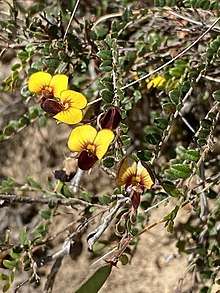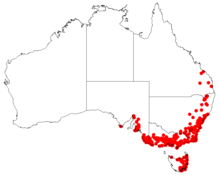Bossiaea prostrata
Bossiaea prostrata, commonly known as creeping bossiaea,[2] is a prostrate understory shrub in the pea family, Fabaceae. It is a widespread species with orange-yellow flowers, purple-brown keels and trailing branches.
| Creeping bossiaea | |
|---|---|
 | |
| Bossiaea prostrata near Taralga | |
| Scientific classification | |
| Kingdom: | Plantae |
| Clade: | Tracheophytes |
| Clade: | Angiosperms |
| Clade: | Eudicots |
| Clade: | Rosids |
| Order: | Fabales |
| Family: | Fabaceae |
| Genus: | Bossiaea |
| Species: | B. prostrata |
| Binomial name | |
| Bossiaea prostrata | |
 | |
| Occurrence data from AVH | |
| Synonyms | |
| |
Description
Bossiaea prostrata is a shrub with a prostrate spreading, scrambling habit to 0.2 m (7.9 in) wide. The leaves are dark green on the upper side and paler on the underside, ovate to rounded or oblong, 3–15 mm (0.12–0.59 in) long, 2–10 mm (0.079–0.394 in) wide and have a petiole about 5 mm (0.20 in) long. The leaves are arranged alternately, simple, smooth or with sparse hairs, stipules narrow to egg-shaped, 1–2 mm (0.039–0.079 in) long. The stems are flattened toward the apex and either smooth or with short flattened or spreading hairs. The flowers are single or in pairs, 6–12 mm (0.24–0.47 in) long, have orange-yellow standards, that are pinkish brown on the back, and purple-brown keels. The pedicels 1–2 cm (0.39–0.79 in) long, bracts 1.5 mm (0.059 in) long. The seed pods are oblong in shape and between 1.5–3.2 cm (0.59–1.26 in) long. Flowering occurs between September and November in its native range. It is similar to the species Bossiaea buxifolia, but may be distinguished by its longer leaves, petioles and pedicels and more distant leaf spacing.[2][3][4][5]
Taxonomy and naming
Bossiaea prostrata was first formally described in 1812 by botanist Robert Brown and the description was published in Hortus Kewensis.[6][7] The specific epithet (prostrata) is a Latin word meaning "down flat", "overthrown" or "laid low",[8]
Distribution and habitat
Creeping bossiaea occurs in South Australia, Victoria, Tasmania, New South Wales and Queensland in Australia. It grows in coastal heath, grassland and open-forest on a variety of soils including clay-shale, preferring wetter locations.[2][9]
References
- "Bossiaea prostrata". Australian Plant Census. Retrieved 23 February 2020.
- "Bossiaea prostrata". VicFLORA. Royal Botanic Gardens Victoria. Retrieved 27 February 2020.
- Wild Plants of Victoria (database). Viridans Biological Databases & Department of Sustainability and Environment. 2009.
- "Bossiaea prostrata". PlantNET - New South Wales Flora Online. Royal Botanic Gardens & Domain Trust, Sydney Australia. Retrieved 13 May 2012.
- "Bossiaea". PlantNET - New South Wales Flora Online. Royal Botanic Gardens & Domain Trust, Sydney Australia. Retrieved 13 May 2012.
- "Bossiaea prostrata". Australian Plant Name Index (APNI), IBIS database. Centre for Plant Biodiversity Research, Australian Government, Canberra. Retrieved 13 May 2012.
- "Hortus Kewensis". Biodiversity Heritage Library. Retrieved 29 February 2020.
- Brown, Roland Wilbur (1956). The Composition of Scientific Words. Washington, D.C.: Smithsonian Institution Press. p. 481.
- Sharp, Sarah; Rehwinkel, Rainer; Mallinson, Dave; Eddy, David (2015). Woodland Flora a Field Guide for the Southern Tableland (NSW & ACT). Canberra: Horizons Print Management. ISBN 9780994495808.